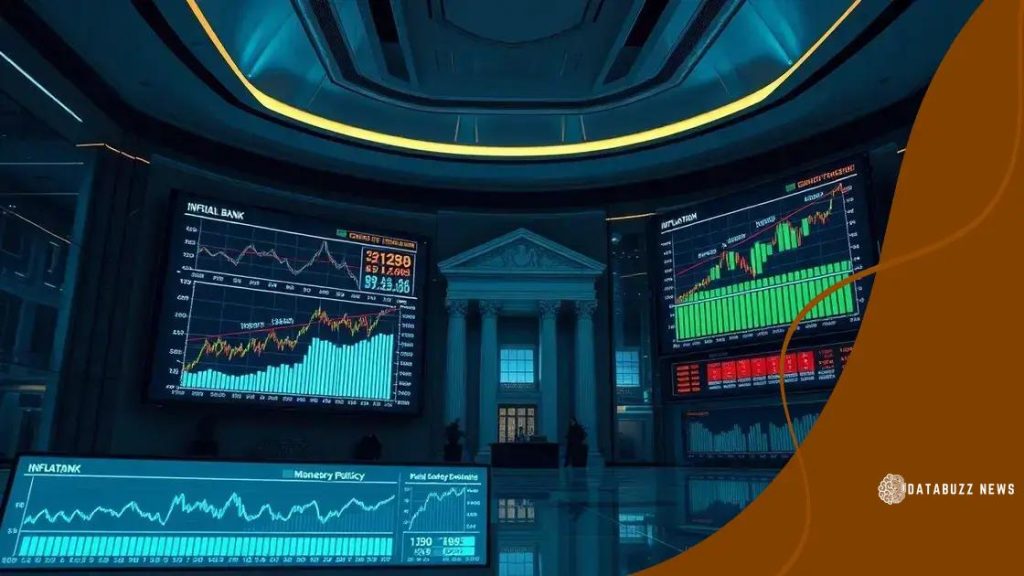Inflation expectations influencing monetary policy dynamics

Inflation expectations significantly influence monetary policy, as central banks adjust interest rates and implement strategies to stabilize the economy based on public perceptions and economic indicators.
Inflation expectations influencing monetary policy are crucial for shaping our economy. Have you ever wondered how these expectations affect your purchasing power? Let’s delve into this important topic.
Understanding inflation expectations
Understanding inflation expectations is vital in today’s economy. These expectations influence how consumers and businesses behave. When people expect prices to rise, they adjust their spending and saving habits accordingly.
What Are Inflation Expectations?
Inflation expectations refer to what individuals and businesses believe will happen to prices in the future. These beliefs can shape economic decisions. If people think prices will increase, they may spend more now rather than later. This can lead to greater demand and, ultimately, actual inflation.
Why Do Inflation Expectations Matter?
Inflation expectations are crucial for monetary policy. Central banks, like the Federal Reserve, monitor these expectations closely. When expectations rise, the central bank might increase interest rates to cool down spending. Conversely, if expectations fall, it could lower rates to encourage spending.
- Increased consumer spending can boost economic growth.
- Businesses might invest more if they expect stable prices.
- High expectations can lead to wage demands from workers.
Furthermore, if inflation expectations become too high, it could create a self-fulfilling prophecy. This happens as companies raise prices in anticipation, resulting in actual inflation.
Understanding these dynamics can help individuals make informed financial decisions. For example, if you expect prices to rise, it might be wise to lock in rates for loans or mortgages sooner rather than later.
How Are Expectations Formed?
Many factors contribute to how inflation expectations are formed. Economic indicators, news reports, and government policy can reshape these beliefs. Individuals often look at factors like:
- The current inflation rate.
- Recent changes in the price of essential goods.
- Statements from trusted economic leaders.
The media also plays a significant role in shaping public perception around inflation, which can either stabilize or destabilize expectations.
Impact of inflation on economic policy
The impact of inflation on economic policy shapes how governments and central banks operate. When inflation rates rise, policymakers have to act carefully to manage the economy. This often leads to changes in interest rates and other financial measures.
The Role of Central Banks
Central banks play a critical role in controlling inflation. They adjust interest rates based on current inflation levels. Higher interest rates can reduce spending and borrowing, while lower rates can encourage these activities. This balancing act is essential for maintaining economic stability.
Fiscal Policies in Response to Inflation
Governments can change fiscal policies to combat inflation. This may involve modifying tax rates or increasing public spending. When the government spends more, it can stimulate the economy. However, if too much money is in circulation, it can lead to higher inflation.
- Reducing taxes can increase disposable income for consumers.
- Increased government spending can stimulate job growth.
- Balanced budgets may help keep inflation in check.
Often, inflation can affect international trade as well. If a country’s inflation rate increases, its goods may become more expensive abroad. This can lead to a trade imbalance and affect the country’s economic health.
Furthermore, inflation impacts consumer behavior. When people see prices rising, they may spend less or seek higher wages to maintain their standard of living. This shift can pressure employers and lead to wage inflation, creating a cycle that policymakers must manage.
Long-term Economic Considerations
Long-term, sustained inflation can change how economies function altogether. It may force policymakers to implement new strategies. Managing expectations becomes crucial to stabilize the economy and assure the public that inflation is under control.
As inflation rises, it can affect various sectors differently, making it vital for policymakers to be adaptable. The ongoing assessment and response to inflation can help mitigate its effects on the economy.
Central bank strategies in addressing inflation

Central banks play a vital role in managing inflation through various strategies. Their primary goal is to keep inflation levels stable and predictable. When inflation rises, the central bank must act quickly to address potential economic issues.
Monetary Policy Tools
One of the main tools central banks use is adjusting interest rates. By increasing rates, borrowing becomes more expensive. This typically reduces spending and slows down inflation. Conversely, lowering interest rates makes borrowing cheaper, encouraging spending and investment.
Open Market Operations
Central banks also engage in open market operations. This involves buying or selling government securities to control the money supply. When a bank buys securities, it pumps money into the economy, potentially increasing inflation. Selling securities does the opposite, reducing the money supply.
- Buying securities can stimulate economic growth.
- Selling securities helps control inflation.
- Effective operation requires careful analysis of market conditions.
Besides interest rates and open market operations, central banks monitor inflation expectations closely. By influencing public perception, they can stabilize the economy. For example, if the public believes the bank can keep inflation in check, their spending habits may remain stable, preventing excessive inflation.
Communication is also crucial. Central banks often provide guidance about future economic plans. This transparency helps manage expectations and can make their strategies more effective.
Quantitative Easing
In times of severe economic downturn, central banks may use quantitative easing (QE). This involves large-scale purchases of assets to inject liquidity into the economy. QE can lower long-term interest rates, encouraging loans and investments, which can lead to economic recovery.
Ultimately, central bank strategies aim to balance growth and inflation. Their ability to adapt to changing economic conditions is essential for maintaining stability. By utilizing various tools and maintaining clear communication, they work to ensure that inflation remains within a manageable range.
The role of public perception in inflation
The role of public perception in inflation is significant. This perception can shape consumer behaviors and economic outcomes. When people believe inflation is rising, they may change how they spend, save, or invest their money.
Inflation Expectations
Inflation expectations influence decisions made by individuals and businesses. If consumers expect prices to rise, they are likely to spend more now rather than later. This behavior can actually contribute to inflation, creating a cycle where expectations lead to increased prices.
Media Influence
The media also plays a critical role in shaping public perception of inflation. News stories can highlight rising prices or economic challenges, affecting how people view their financial situation. When inflation makes headlines, it can lead to heightened awareness, prompting people to react swiftly.
- Positive news can reassure consumers about economic stability.
- Negative news may prompt cautious spending habits.
- Understanding media narratives helps consumers make informed decisions.
Public sentiment can be swayed by social media as well. Online discussions about prices can lead to widespread anxiety about inflation. This can result in consumers rushing to purchase goods before prices increase, further fueling inflation.
Another aspect to consider is how businesses react to public perception. If companies sense growing inflation fears, they may raise prices preemptively. This reaction can create inflationary pressure even before actual costs have increased.
Trust in Institutions
The level of trust that consumers place in economic institutions also impacts their perceptions. If people believe central banks and governments are taking effective steps to control inflation, they may be less likely to panic. Trust can lead to stable inflation expectations, while distrust can create uncertainty.
Understanding the role of public perception in inflation is crucial for both consumers and policymakers. When perceptions align with actual economic conditions, it can lead to a more stable financial environment. However, mismatched expectations can create volatility and further economic challenges.
Future outlook on monetary policy adjustments
The future outlook on monetary policy adjustments is crucial for economic stability. As economies evolve, central banks must adapt their strategies to manage inflation and foster growth effectively. Understanding this future is important for businesses and consumers alike.
Adapting to Changing Economic Conditions
Central banks will likely continue to adjust their policies based on economic indicators. Factors such as unemployment rates, consumer spending, and global economic trends significantly influence these decisions. For example, if inflation continues to rise, central banks may consider increasing interest rates to cool down spending.
Emerging Economic Challenges
Future adjustments may also respond to new challenges, such as technological advancements and shifts in consumer behavior. The rise of digital currencies and online transactions could affect traditional monetary policy tools. Central banks need to stay informed and agile to address these changes effectively.
- New technologies may enable faster payment systems.
- Changing consumer preferences could shift demand patterns.
- Globalization complicates inflation management and economic monitoring.
Interest rates will remain a fundamental tool for managing inflation. However, the approach to implementing changes may evolve. For example, central banks may implement gradual increases to avoid shocking the market. This method helps ensure that adjustments remain predictable and do not disrupt economic stability.
Long-Term Strategies
Expectations around interest rates are also likely to influence future monetary policy. If inflation expectations become anchored, it may lead to more stable economic conditions. Central banks might focus on building credibility and trust with the public to maintain these expectations.
Moreover, communication strategies will play a vital role. Clear messaging about policy plans helps guide consumer and business behavior, allowing for smoother transitions during adjustments. As central banks adapt, they must ensure their messaging aligns with overall economic goals.
Ultimately, the future of monetary policy adjustments lies in a careful balance between responding to immediate economic conditions and anticipating future trends. Effective management of these elements will be essential for maintaining economic health and stability.
FAQ – Frequently Asked Questions about Monetary Policy and Inflation
What is the main goal of central banks in managing inflation?
The main goal of central banks is to maintain stable inflation and promote economic growth through effective monetary policy adjustments.
How do interest rate changes affect inflation?
Increasing interest rates can help reduce inflation by making borrowing more expensive, while lowering rates can stimulate spending and investment.
Why is public perception important in inflation management?
Public perception influences consumer behavior and expectations, affecting spending habits and can contribute to the actual inflation rate.
What impact do global events have on monetary policy?
Global events can significantly influence economic conditions, requiring central banks to adjust their monetary policies to respond to international trends and challenges.
